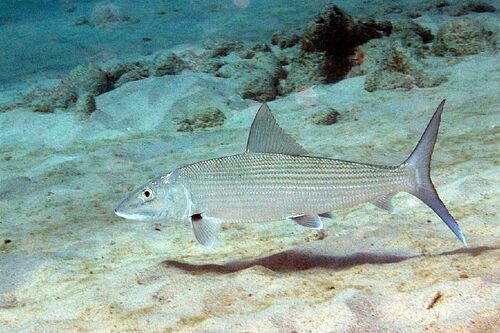
Bonefish
The Bluefin Tuna (Thunnus) are a group of large, powerful, and highly migratory fish belonging to the Scombridae family. Renowned for their incredible speed, size, and commercial value, they are apex predators in the marine ecosystem. They are also critical component of the marine food web.
1 19 years
Lifespan
90 cm
Length
Near Threatened
Conservation Status
40 km/h
Swimming speed
Carnivorous
Diet
Local Migration
Migration
Appearance Overview
The Bluefin Tuna is renowned for its large, streamlined body, built for speed and endurance in the open ocean.
Coloration
Dark metallic blue above, shimmering silver-white below
Body Shape
Torpedo-shaped, with a crescent-shaped tail
Fins
Two dorsal fins, the first depressible; small finlets running from dorsal and anal fins to tail
Length
Up to 10 feet (3 meters), commonly 6.5 feet (2 meters)
Weight
Up to 1,500 lbs (680 kg), commonly around 550 lbs (250 kg)
Diet
Carnivorous, feeding on a variety of fish (like mackerel, herring, and hake), squid, and crustaceans. Also consumes eels and other invertebrates.
Feeding Behavior
An opportunistic predator, the Bluefin Tuna uses its speed and agility to hunt. They often feed cooperatively, herding and trapping prey.
Social Behavior
Highly migratory, forming large schools, especially during spawning. Schools may segregate by size. Shows complex social behaviors.
Commercial Relevance
Extremely high value, particularly in the sushi and sashimi markets. Bluefin tuna is one of the most commercially valuable fish species.
Conservation measures
Subject to international fishing quotas and regulations (e.g., ICCAT). Marine protected areas and efforts to reduce bycatch also in place.
Status
Varies by species: Atlantic Bluefin - Endangered; Pacific Bluefin - Vulnerable; Southern Bluefin - Critically Endangered.
Threats
Overfishing is the primary threat. Other threats include habitat degradation, climate change, and bycatch in fisheries targeting other species.
Habitat Distribution
Depth Range
Typically found from the surface to depths of 0-900 meters (0-3,000 feet), depending on the species and location.
Geographic Range
Atlantic Ocean, Pacific Ocean, Indian Ocean and the Mediterranean Sea.
Preferred Environment
Pelagic, open ocean environments; prefers temperate waters but can range into colder or warmer areas during migrations.
Reproduction and Life Cycle
Breeding Habits
Spawns in specific areas, such as the Mediterranean Sea and the Gulf of Mexico for Atlantic Bluefin. Spawning is often temperature-dependent.
Development Stages
Larvae are planktonic, undergoing rapid growth. Juveniles develop into highly migratory adults, continuing to grow for many years.
Fecundity
Highly fecund; a single female can produce millions of eggs per spawning season, releasing them into the water for external fertilization.
Maturity Age
Varies by species: Atlantic Bluefin typically mature at 4-8 years, while Southern Bluefin may take longer.
Faqs about Bonefish
Where can Bluefin Tuna be found?
Bluefin tuna are found in the Atlantic, Pacific, and Indian Oceans, including the Mediterranean Sea. They are highly migratory.
How long do Bluefin Tuna live?
Bluefin tuna can live up to 40 years, although this varies by species.
Are Bluefin tuna warm-blooded?
Yes, Bluefin tuna are warm-blooded, which helps them maintain high speeds and activity levels in cold waters.
How fast can Bluefin Tuna swim?
Bluefin Tuna are among the fastest fish in the ocean, capable of bursts of speed up to 43 mph (70 km/h).
Are Bluefin Tuna endangered?
While not all Bluefin tuna populations are endangered, their numbers have significantly declined due to overfishing.
Copyright @ Nature Style Limited. All Rights Reserved.
 English
English